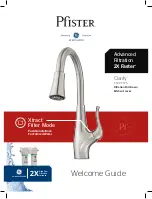
B
A
B
A
B
A
B
A
Groove at
bottom
Lower bracket
B
A
Decide on the position of the riser rail on the
wall within the shower area. Proceed as follows:
Position the lower bracket to the wall and mark
fixing hole ‘A’. Make sure to position the bracket
correctly with the groove towards the bottom of
the bracket
(fig.1)
.
Drill and plug the wall.
(The wall plugs provided
are suitable for most brick walls — use an
appropriate masonry drill, but if the wall is
plasterboard or a soft building block, you must use
suitable wall plugs and an appropriate drill bit).
Note:
That the holes are elongated at the back
of the bracket to allow for a small amount of
adjustment.
Locate the riser rail and lower bracket to the
wall and fix temporarily using the long screw
provided. Fit the upper bracket to the riser rail,
making sure to position the bracket with the
groove uppermost. Align the holes in the riser
rail and upper bracket.
With the upper bracket in place, align vertically
the rail and mark fixing position 'A'
(fig.2)
.
Remove the rail assembly. Drill and plug the wall.
Screw temporarily both brackets to the wall. To
check the brackets are aligned, place the riser rail
into the curved recess of both brackets
(fig.3)
.
Remove the rail, mark the two remaining fixing
holes ‘B’ and drill and plug the wall.
Fix the brackets to the wall using the short
screws in hole ‘B’.
Slide the showerhead holder onto the riser rail.
For the correct facing of the showerhead holder
make sure that the holes align and the lever is
facing forwards. Secure the holder to the rail by
turning the lever anti-clockwise. When tight, the
lever should face down
(fig.4)
.
ANdrew rISer rAIL ASSeMBLY
wArNINg!
Check there are no hidden cables or
pipes before drilling holes for wall
plugs. Use great care when using
power tools near water. The use of
a residual current device (rCd) is
recommended.
Tapered
thin end
at top
Lever facing
down
Fig.1
Fig.4
Groove at top
Upper bracket
B
A
B
A
Fig.2
Fig.3
Upper bracket
Lower bracket






















